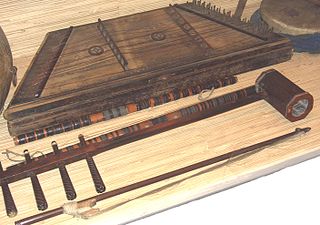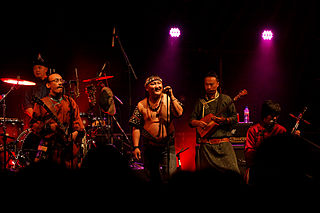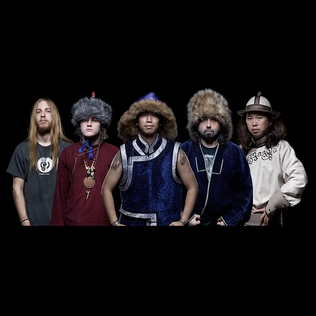Related Research Articles

Music is an integral part of Mongolian culture. Among the unique contributions of Mongolia to the world's musical culture are the long songs, overtone singing and morin khuur, the horse-headed fiddle. The music of Mongolia is also rich with varieties related to the various ethnic groups of the country: Oirats, Hotogoid, Tuvans, Darhad, Buryats, Tsaatan, Dariganga, Uzemchins, Barga, Kazakhs and Khalha.

The morin khuur, also known as the horsehead fiddle, is a traditional Mongolian bowed stringed instrument. It is one of the most important musical instruments of the Mongol people, and is considered a symbol of the nation of Mongolia. The morin khuur is one of the Masterpieces of the Oral and Intangible Heritage of Humanity identified by UNESCO.
The igil is a two-stringed Tuvan musical instrument, played by bowing the strings. The neck and lute-shaped sound box are usually made of a solid piece of pine or larch. The top of the sound box may be covered with skin or a thin wooden plate. The strings, and those of the bow, are traditionally made of hair from a horse's tail, but may also be made of nylon. Like the morin khuur of Mongolia, the igil typically features a carved horse's head at the top of the neck above the tuning pegs, and both instruments are known as the horsehead fiddle.
Buryatia is a part of the Russian Federation. One of the country's main instruments is a two-stringed horse-head fiddle called a morin khuur. This is an instrument closely linked to the all-important cult of the horse, belonging to the intangible heritage of all Mongolic peoples. Other elements of Buryat music, such as the use of fourths both in tuning instruments and in songs, and pentatonic scales, reveal similarities to music from Siberia and Eastern Asia. There traditionally was no polyphony, instead voices and instruments performed the same melody in unison but varied in timing and ornamentation.
The music of Kalmykia, a national republic within Russia, has roots in the musical culture of the Oirats. Traditional instruments include the dombra, which is used to accompany dance music. The state folk ensemble Tulpan was formed in 1937 to promote traditional Kalmyk music.

Yat-Kha is a band from Tuva, led by vocalist/guitarist Albert Kuvezin. Their music is a mixture of Tuvan traditional music and rock, featuring Kuvezin's distinctive kargyraa throat singing style, the kanzat kargyraa.

The sihu is a Chinese bowed string instrument with four strings. It is a member of the huqin family of instruments.

The long song is one of the central elements of the traditional music of Mongolia. This genre is called "Long song" not only because the songs are long, but also because each syllable of text is extended for a long duration. A four-minute song may only consist of ten words. Certain long songs such as Uvgin shuvuu khoyor, also known as Jargaltain delger take up to three hours to sing at full length, with all thirty-two stanzas. Lyrical themes vary depending on context; they can be philosophical, religious, romantic, or celebratory, and often use horses as a symbol or theme repeated throughout the song. Eastern Mongols typically use a Morin khuur as accompaniment, sometimes with a type of indigenous flute, called limbe. Oirat groups of the Western Mongols traditionally sing long songs unaccompanied or accompanied with the Igil.

Egschiglen are a Mongolian folk band, formed in Ulan Bator in 1991. In English, Egschiglen means "Beautiful Melody", and they are one of very few traditional Mongolian bands to have become internationally popular.

Hanggai is an Inner Mongolian folk music group based in Beijing who specialize in a blend of Mongolian folk music and more modern styles such as punk rock. Their songs incorporate traditional folk lyrics as well as original compositions, and are sung in Mongolian and Mandarin.
Altan Urag is a Mongolian folk rock band. Formed in 2002, the band's musical style combines traditional Mongolian and contemporary influences. They're considered to be the pioneers of mongolian folk-rock.
Natsagiin Jantsannorov is a Mongolian composer.

Tengger Cavalry was a heavy metal band originated from Inner Mongolia and Beijing and formerly based in New York state and Texas. They combine elements of the traditional music of Central Asia and music of Mongolia with heavy metal into a kind of folk metal that Billboard and CNN refer to as nomadic folk metal.
Myagmarsürengiin Dorjdagva ; 1986) is a long-song singer from Mongolia and an independent long-song researcher. In 2007-2021, he served as a researcher at the International Institute for the Study of Nomadic Civilizations (IISNC), an international institution established upon the initiative and support of UNESCO in 1998.

The Hu is a Mongolian folk metal band formed in 2016. Incorporating traditional Mongolian instrumentation, including the morin khuur, the tovshuur, and throat singing, the band calls their style of music "hunnu rock", a term inspired by the Xiongnu, an ancient nomadic empire based in Mongolia proper, known as Hünnü in Mongolian. Some of the band's lyrics include old Mongolian war cries and poetry in the Mongolian language.

The Gereg is the debut album by the Hu, released on September 13, 2019. The album takes its name from the diplomatic passport carried by Mongolian nobles and officials during the 13th century.
HAYA is a Chinese band. Founded in 2006, they integrate Mongolian music with modern pop music elements.
Batzorig Vaanchig is a Mongolian throat singer. He first garnered attention for a video of him singing "Chinggis Khaanii Magtaal" on top of a mountain in Mongolia. He later sang more Mongolian folk songs using his throat singing skills.
Aryun-Goa, born Aryuna Nimaeva, is a Buryat singer, musician and composer from Russia. She is known for blending traditional Buryat and Mongolian music with contemporary styles like hard rock. Aryun-Goa is the lead vocalist of the ethno-rock band NukeR.

Live at Glastonbury is the first live album by the Mongolian folk metal band the Hu, released by Better Noise Music on digital download and streaming media platforms on 07 June 2024, and on CD and vinyl formats on 21 June 2024. The album was recorded at the band's appearance at the Glastonbury Festival 2023 on 25 June 2023.
References
- 1 2 Khusugtun - Mongolian music in London - BBC Proms 2011 Human Planet, 12 August 2011, retrieved 2024-02-28
- ↑ "First Ever Winner of "Asia's Got Talent" on AXN - News". www.axn-asia.com. Retrieved 2024-03-27.
- ↑ "KHUSUGTUN | ETHNIC BALLAD GROUP". khusugtun.artplus.mn. Retrieved 2024-02-28.
- ↑ "Khusugtun". Spotify. Retrieved 2024-04-02.